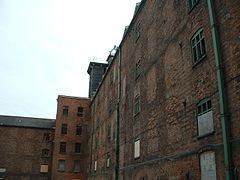Country United Kingdom Construction started 1796 | Completed 1797 Opened 1797 | |
 | ||
Cost £17000 (including the cost of mill equipment) Similar Ditherington, Lord Hill's Column, Town Walls Tower, Shropshire Regimental Museum, Coleham Pumping Station | ||
Ditherington flax mill maltings in shrewsbury
Ditherington Flax Mill, a Flax mill located in Ditherington, a suburb of Shrewsbury, England, is the first iron-framed building in the world. As such, it is seen as the world's first skyscraper described as "the grandfather of skyscrapers", despite being only as tall as a modern five-storey building. Its importance was officially recognised in the 1950s, resulting in it becoming a Grade I listed building. It is also locally known as the "Maltings" from its later use.
Contents
Map of Ditherington Flax Mill, Shrewsbury, UK
It is derelict, and is in the hands of Historic England. Plans to transform the site into offices and shops were given approval in October 2010.
The Flax Mill's architect was Charles Bage, who designed the mill using an iron-framed structure, inspired by the work of William Strutt. The construction of the mill ran from 1796 to 1797, at a cost (including equipment) of £17000.
The mill was built for John Marshall of Leeds, Thomas Benyon, and Benjamin Benyon. The architect, Bage, was also a partner in the venture. This partnership was dissolved in 1804, the mill being retained by John Marshall, who paid off his partners on the basis that it was worth £64000. Castlefields Mill was built by the other partners nearby. These two flax mills provided the 'chief manufacture' of Shrewsbury (according to an 1851 directory). The mill closed in 1886, and was sold (with a bleach yard at Hanwood) for a mere £3000. The building was then converted to a maltings (hence its more commonly used local name), and as a consequence many windows were bricked up.
Its design effectively overcame much of the problem of fire damage from flammable atmosphere, due to the air containing many fibres, by using a fireproof combination of cast iron columns and cast iron beams, a system which later developed into the modern steel frame which made skyscrapers possible.
Along with the main Flax Mill, a number of other buildings in the group are listed for their architectural and historic value: the apprentice house (Grade II*); the dye house (Grade II*); the flax dressing building (Grade II*); the flax warehouse (Grade II); the stables (Grade II); and the workshops and offices (Grade II). The mill and buildings are on the Heritage at Risk Register.
